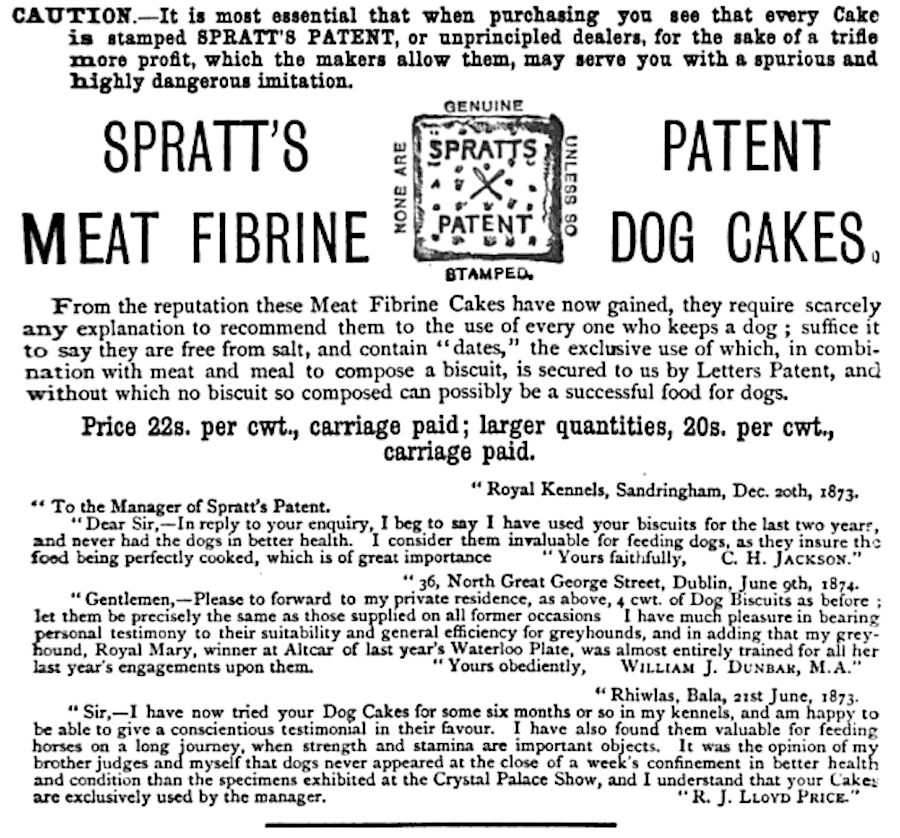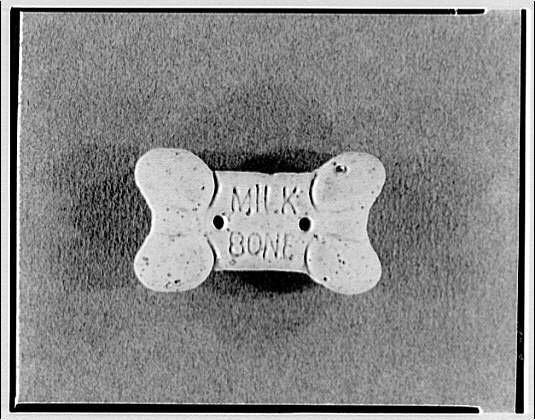How an Organic Chemist Invented the Bone-Shaped Dog Treat
The birth of the Milk-Bone happened pretty much on a whim.

The first dog biscuits did not resemble the bone-shaped delights of today. Developed by James Spratt in 1860, these so-called Meat Fibrine Dog Cakes were woefully square.
Spratt, an American electrician, came up with the idea for a dog biscuit after he witnessed sailors dropping hardtack—an unleavened bread—for the local dogs. He decided he could do the same—and monetize it. His flagship company, Spratt’s, was founded soon after. Their lead product, the Meat Fibrine Dog Cakes, were developed from a combination of wheat, beetroot, vegetables, and prairie meat. (The particular kind of meat in Spratt’s formula was apparently highly confidential; until his death, Spratt “kept in his hands the contract for his meat supplier.”)
At the time, the concept of a food specifically for dogs was alien. According to Katherine C. Grier, author of Pets in America, “until well into the 20th century, most household dogs lived off scraps from the kitchen, often cooked with a starch into something that people called ‘dog stew.’” But by the late 1800s, Spratt’s had shuttled dog biscuits into the mainstream—especially for dog show contestants. In 1895, the New York Times labeled Spratt’s a “principal food” of dog shows.
Spratt’s success soon spawned competition.

Over a decade later, in 1907, organic chemist Carleton Ellis received an urgent request. The owner of a local slaughterhouse was having problems with all of his excess “waste milk,” and he wanted Ellis to help him find a use for it. Ellis would eventually accrue over 753 inventions to his name and would serve as the force behind the creation of margarine, polyester, paint and varnish remover, and anti-knock gasoline. If he found the milk request odd, he did not show it. He agreed to help.
Likely inspired by Spratt’s, Ellis decided to turn the waste into food for his dog. After some experimentation, Ellis mixed the excess milk with malt, grain, and other products to form a dog biscuit—baked into what he assumed would be an appealing, rounded shape.
But when he tested the biscuits, his dog refused to eat them.
Ellis was frustrated. Clearly, the biscuit should have tasted great to a dog. He was a MIT graduate; he knew perhaps more than anyone at the time about the compounds in petroleums, oils, and varnishes. He had authored such dense, technical manuals as Hydrogenation of Oils Catalyze and The Chemical Action of Ultraviolet Rays for biscuit’s sake! Developing a treat that a dog would eat should not have provided this much of a challenge.
So he decided to do something strange: he changed the design of the biscuit rather than the ingredients. “I had some more biscuits baked from the same stock, but in the shape of a bone,” he told Popular Science in 1937, “and I found that my dog manifested a tremendous interest in the bone-shaped biscuit.”
Ellis likely did not choose the bone-shape gimmick accidentally. According to Grier, the association between dogs and bones had already been well established. At the time, butchers sold meat with the bones still in, and many families used them in soups and broths. “At the end the bone was turned over to the family dog, who gnawed what was left of it.”

Ellis soon transferred his patent to the F. H. Bennett Biscuit Company (whose name would later change to the Wheatsworth Company), and they began mass-producing his bone-shaped dog treats. In 1915, the biscuits earned the moniker of Milk-Bone for their high percentage of cow’s milk.
The Milk-Bone proved a worthy competitor to Spratt’s Dog Cakes, and in 1931, the snack company Nabisco purchased it. Nabisco’s grocery store connections gave the treat—which was marketed as a “dog’s dessert”—widespread exposure. Add in a slick post-World War II TV marketing campaign featuring the German shepherd from The Adventures of Rin Tin Tin, and the Milk-Bone achieved ubiquity.
Today, dog biscuits in the shape of bones are unquestioned—a cute gimmick that all pet owners can support. But had it not been for the whims of an organic chemist’s dog, they may not have ever dominated the market in the way they do now.
Even until his death, Carleton Ellis couldn’t decide whether his dog gravitated toward the bone-shaped biscuits because he liked the design “or whether, after my shaping the biscuit in an effort to cater to his taste, he [felt] duty bound to fool his master by simulating an interest in it.”
Gastro Obscura covers the world’s most wondrous food and drink.
Sign up for our regular newsletter.









































Follow us on Twitter to get the latest on the world's hidden wonders.
Like us on Facebook to get the latest on the world's hidden wonders.
Follow us on Twitter Like us on Facebook